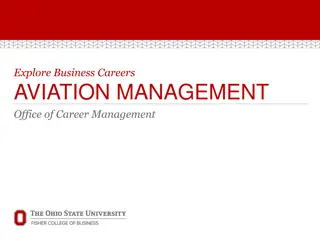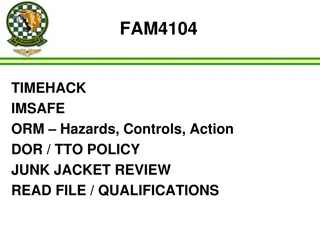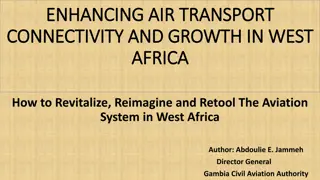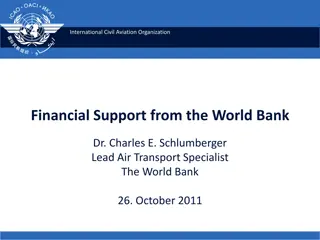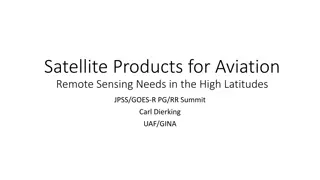Understanding the Importance of the Turn-back Maneuver in Aviation
Exploring the critical aspects of executing a successful turn-back maneuver after an engine failure during takeoff, this article delves into the factors influencing pilot decisions, the controversy surrounding altitude requirements, and the geometric and aerodynamic complexities involved. Knowing the narrow envelope for a potentially successful turn-back can prevent pilots from attempting the impossible and facing fatal outcomes. Understanding altitude loss under varying conditions and proper scaling techniques are highlighted for pilot safety.
Download Presentation

Please find below an Image/Link to download the presentation.
The content on the website is provided AS IS for your information and personal use only. It may not be sold, licensed, or shared on other websites without obtaining consent from the author. Download presentation by click this link. If you encounter any issues during the download, it is possible that the publisher has removed the file from their server.
E N D
Presentation Transcript
Single-Engine Failure After Takeoff: The Anatomy of a Turn-back Maneuver Part 1 Les Glatt, Ph.D. ATP/CFI-AI VNY FSDO FAASTeam Representative lgtech@roadrunner.com (818) 414-6890 Checked Out From The SAFE Members Only Resource Center Society of Aviation and Flight Educators www.safepilots.org 1
Dave Kellers Successful Turn-back in a Mooney 20C Camera installed in the aircraft the previous day Pilot accomplished a successful turn-back maneuver after engine malfunction in a 1967 Mooney 20C AOPA website shows the entire flight of the Mooney which departed Anderson airport in Indiana Was the successful turn-back maneuver based on pilot skill, luck, or a combination of the two? DO YOU BELIEVE THAT DAVE KELLER HAD ANY IDEA THAT HE HAD SUFFICIENT ALTITUDE TO EXECUTE A SUCCESSFUL TURN-BACK MANEUVER BEFORE HE ACTUALLY TURNED BACK? 2 *
Comments about the Turn-back Controversy Turn-back controversy can be rendered moot if the pilot knows he/she does not have sufficient altitude to make it back The pilot community would benefit greatly if pilots knew how much altitude was necessary to execute the turn-back maneuver Clearly the altitude loss depends on a number of important factors which need to be understood by pilots 3
Why is the Turn-back Maneuver Important to Understand? Although the geometry of the turn-back maneuver appears to be relatively simple, the Devil is in the Details Understanding the Turn-back Maneuver from both a geometric and aerodynamic viewpoint is straightforward but extremely informative in helping a pilot to understand the actual complexity and limitations of the maneuver Envelope for a potentially successful turn-back maneuver is narrow Knowing where this envelope lies prior to take-off can avoid the fatal mistake of attempting the Impossible Turn-back 4
Why is the Turn-back Maneuver Important to Understand? (Cont.) Determining the altitude loss during a turn-back maneuver under one set of condition cannot blindly be extrapolated to another set of conditions Pilots need to understand how to scale their results between different sets of conditions Without the proper scaling the outcome could be fatal 5 *
What is the Objective of this Seminar? PROVIDE YOU WITH THE KNOWLEDGE YOU NEED TO KNOW ABOUT THE TURN-BACK MANEUVER SO THAT YOU DO NOT BECOME JUST ANOTHER NTSB ACCIDENT STATISTIC 6
Accomplishing this Objective Determine the required altitude above the runway versus distance from the departure end of the runway (DER) for which a potentially successful turn-back maneuver can be achieved Develop a chart that a pilot can use prior to departure that shows when NEVER TO ATTEMPT A TURN-BACK MANEUVER Take-off techniques that can improve the pilot s chances of a potentially successful turn-back maneuver 7 *
Agenda Factors that control the turn-back maneuver Turn-back scenarios Important aspects of the geometry of the turn-back maneuver Basic aerodynamics of the turn-back maneuver Factors that affect the altitude loss during the turn-back How to select the bank angle and airspeed to minimize the altitude loss during the turn-back Determining the envelope for a potentially successful turn- back maneuver Turn-back maneuver at high density altitude airports Effects of the wind on the turn-back maneuver Summarize 8 *
What are the Factors that Control the Turn-back Maneuver? Aerodynamics of the aircraft Determines the performance of the aircraft during the turn-back Environment (wind) Modifies the aerodynamic performance Pilot skills Important only if the combination of aerodynamics and environment allows for a potentially successful turn-back 10 *
What are the Ground Rules for the Turn-back Maneuver? Will not stall the aircraft Airspeed must be greater than the accelerated stall speed for the given bank angle and weight of the aircraft Will not overstress the aircraft Load factor less than 3.8 g s for normal category aircraft 11 *
Possible Runway Configurations Case 1 Case 2 Case 3 L L L D Parallel Runways Characterized by Length L and Separation Distance D Intersecting Runways Characterized by Length L and Angle Single Runway Characterized by Length L 12 *
Keyhole/Racetrack Turn-back Scenario Requires two turns: (180- ) and (180+ ) plus one straight leg Can be employed Over runway Upwind leg Requires long runway lengths Dissipate altitude by extending straight leg V1 , 1 ` V2 , 2=0 V3 , 3 14
Teardrop Turn-back Scenario Requires one turn of 180 + deg, one straight leg, and another turn of deg Employed on the upwind leg Requires less altitude than the Keyhole/Racetrack Scenario Less restrictive runway lengths required Dissipate altitude by S- turns on straight leg V1 , 1 V2 , 2=0 V3 , 3 15
270-90 Turn-back Scenario R0 R0 DER R0 R0 Segment 3 Requires a 270 deg followed by a 90 deg turn Very risky maneuver especially with a wind Segment 1 16 *
Discuss both the Teardrop and Keyhole/Racetrack Scenario 17
Understanding the Geometry of the Teardrop Turn-back Maneuver 18
Geometry of the Teardrop Turn-back Maneuver (No Wind Case) Segments of the turn-back maneuver 90 Intercept Angle (deg) 80 70 60 50 40 30 (V2 ,2=0) Segment 2 20 Segment 1 (V1, 1) 10 R1 0 0 2 4 6 Distance from D/R1 8 10 12 14 16 18 R3 D (V3, 3) R1 Segment 3 D L 19 *
Minimum Distance from DER to Initial Turn-back Maneuver 2.5 Minimum Distance to Initiate a Turn-back 2.25 /Radius Segment 1 2 1.75 1.5 1.25 1 1 1.5 2 Turn Radius Segment 3 / Turn Radius Segment 1 2.5 3 3.5 4 4.5 5 20
Unusable Runway Length for Teardrop Turn-back Maneuver 1.2 1 Unusable Runway Length / R3 0.8 0.6 0.4 0.2 0 0 10 20 30 40 Intercept Angle (deg) 50 60 70 80 90 100 21 *
What Do We Need to Know about Basic Aerodynamics? All Practical Test Standards are Based on Specific References Including the Pilot s Handbook of Aeronautical Knowledge : FAA-H-8083-25 Basic Aerodynamic Knowledge Needed to Understand the Turn-back Maneuver is in these Chapters Chapter 3- Principles of Flight Chapter 4- Aerodynamics of Flight Chapter 10 Aircraft Performance
What is Aerodynamics? Aerodynamics is a branch of dynamics concerned with studying the motion of air and its interaction with a moving object Determines the forces and moments on the aircraft Determines the performance, stability and control of the aircraft Based on Newton s laws of motion
What is Newtons First Law of Motion? Every object in a state of uniform motion tends to remain in that state of motion unless acted on by an external force (Law of Inertia) If the sum of all the forces on the aircraft is zero Aircraft is in a state of equilibrium (steady state) Constant airspeed
What is Newtons Second Law of Motion? The relationship between an object's mass, its acceleration , and the applied force is just Force = mass x acceleration If the sum of the external forces on the aircraft is non-zero Aircraft is in a state of transition (unsteady state) Airspeed changing
Why Do We Need to Understand Aircraft Performance? Determining the altitude loss in a gliding turn or a wings- level glide requires one to understand aircraft performance Aircraft performance requires us look at the balance of forces on the aircraft during flight Forces and velocities are considered vectors They have both magnitude and direction 27
Understanding Aircraft Performance (Cont.) Aerodynamics forces are usually broken down into components Along the flight path Perpendicular to the flight path The balance of forces along these directions provide the information we need to determine the aircraft performance 28
Understanding Vectors and Components Components of the velocity vector VX_WIND VH_WIND VWind Right triangle relationships = V V Sin X - WIND WIND = V V Cos H - WIND WIND V Sin = Tan = X - WIND V Cos H - WIND 29
Values of Sin and Cos (degrees) Sin Cos 0 0 1 30 0.5 0.866 45 0.707 0.707 60 0.866 0.5 90 1.0 0 = V V Cos = V V Sin H - WIND WIND X - WIND WIND Cos + 1 = Sin 2 2 (VWIND )2 = (VH_WIND)2 + (VX_WIND) 2 30
Simple Geometry of the Aircraft in a Glide Horizontal Ground Plane Glide Path Angle VV= V Sin VH= V Cos V VV VH *Q 31
What is the First Myth of Gliding Flight? Two identical C-172 s are flying next to each other at 9000 AGL Aircraft #1 weighs 2400 lbs and aircraft #2 weighs 2000 lbs Both aircraft incur engine failures at the same time Question: Which aircraft can glide the farthest before it runs out of altitude? Answer: Both aircraft can glide the same distance WHY? 32
What are the Forces Acting on the Aircraft During a Glide? 1 Lift = ( L C V S ) 2 2 L Lift Coefficient Density of Air TAS Squared Wing Area 1 = D C ( D V S ) Drag 2 2 Drag Coefficient Weight 33
Important Glide Parameters There are two important aerodynamic parameters that affect the aircraft performance in a glide L= C Wings-Level Glide Lift to drag ratio L D C D L Product of the lift coefficient and the L/D ratio C D L Gliding Turn Both parameters are only functions of the angle-of-attack 34
Aircraft in a Steady Wings-Level Glide 35
Forces Acting on Aircraft in a Steady Wings-Level Glide Flight Path Angle % Weight Parallel % Weight Perpendicular 0 0 100 5 8.7 99.6 10 17.4 98.5 15 25.9 96.6 WA Pitch Attitude WA= W Sin W WP= W Cos WP V Flight Path Angle = Pitch Attitude - Angle-of-Attack 36
Parameters that Characterize a Steady Wings- Level Glide Airspeed (V) Angle-of-Attack ( ) Flight path angle ( ) Balance of forces along and perpendicular to the flight path provide two relationships between the 3 variables Third variable can be arbitrarily chosen Airspeed is the appropriate variable to select since the pilot has control of that parameter using the airspeed indicator 37
Example of Balance of Forces in a Wings-Level Glide Along the flight path W = A= D W Sin D Sin = = Tan Perpendicular to the flight path L Cos W = P= L W Cos 1 Tan = (L/D) 38
What is the Glide Path Angle in a Wing-Level Glide? 1 = Tan L/D Shallowest glide path angle occurs at angle-of-attack for which L/D is a maximum Angle-of-attack where the induced drag and parasite drag are equal Independent of aircraft weight and the altitude 39
C-172 Glide Chart From POH V VV VH 40
Calculating Maximum L/D Ratio for C-172 with Propeller Wind milling D = 18 NM 1 NM = 6076 feet D = 109,368 feet H=12000 feet H/D = 12000/109368 = 0.11 (L/D)max = 1/0.11 = 9.09 Best glide angle = 6.3 degrees below the horizon Occurs at 65 KIAS at gross weight 41
Effect of a Wind milling Propeller on the L/D Ratio for C-172 12 11 10 9 8 7 L/D 6 Stall angle-of-attack 5 L/D_idle 4 L/D_prop_windmilling 3 2 1 0 -4 -2 0 2 4 6 Angle-of-attack 8 10 12 14 16 18 20 22 42
How Do We Determine the Altitude Lost in a Wings-Level Glide? 43
Height Loss During Wings-Level Glide Height loss during the wings-level glide is Horizontal Distance Traveled H = (L/D) max H = 0.11 x Horizontal Distance Traveled (C-172) In segment 2 the aircraft loses 110 feet of altitude for every thousand feet traveled horizontally under no wind condition Independent of the weight and altitude of the aircraft 44










